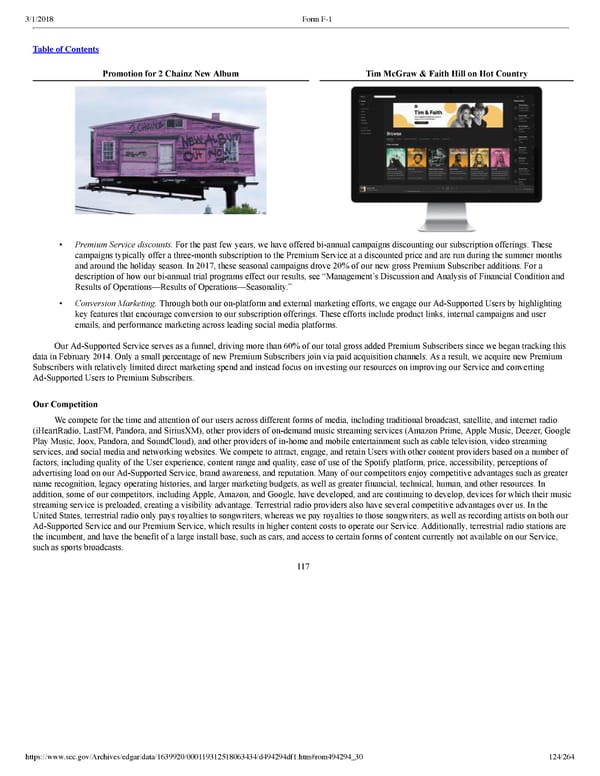124/264 Promotion for 2 Chainz New Album Tim McGraw & Faith Hill on Hot Country • Premium Service discounts. For the past few years, we have offered biannual campaigns discounting our subscription offerings. These campaigns typically offer a threemonth subscription to the Premium Service at a discounted price and are run during the summer months and around the holiday season. In 2017, these seasonal campaigns drove 20% of our new gross Premium Subscriber additions. For a description of how our biannual trial programs effect our results, see “Management’s Discussion and Analysis of Financial Condition and Results of Operations—Results of Operations—Seasonality.” • Conversion Marketing. Through both our onplatform and external marketing efforts, we engage our AdSupported Users by highlighting key features that encourage conversion to our subscription offerings. These efforts include product links, internal campaigns and user emails, and performance marketing across leading social media platforms. Our AdSupported Service serves as a funnel, driving more than 60% of our total gross added Premium Subscribers since we began tracking this data in February 2014. Only a small percentage of new Premium Subscribers join via paid acquisition channels. As a result, we acquire new Premium Subscribers with relatively limited direct marketing spend and instead focus on investing our resources on improving our Service and converting AdSupported Users to Premium Subscribers. Our Competition We compete for the time and attention of our users across different forms of media, including traditional broadcast, satellite, and internet radio (iHeartRadio, LastFM, Pandora, and SiriusXM), other providers of ondemand music streaming services (Amazon Prime, Apple Music, Deezer, Google Play Music, Joox, Pandora, and SoundCloud), and other providers of inhome and mobile entertainment such as cable television, video streaming services, and social media and networking websites. We compete to attract, engage, and retain Users with other content providers based on a number of factors, including quality of the User experience, content range and quality, ease of use of the Spotify platform, price, accessibility, perceptions of advertising load on our AdSupported Service, brand awareness, and reputation. Many of our competitors enjoy competitive advantages such as greater name recognition, legacy operating histories, and larger marketing budgets, as well as greater financial, technical, human, and other resources. In addition, some of our competitors, including Apple, Amazon, and Google, have developed, and are continuing to develop, devices for which their music streaming service is preloaded, creating a visibility advantage. Terrestrial radio providers also have several competitive advantages over us. In the United States, terrestrial radio only pays royalties to songwriters, whereas we pay royalties to those songwriters, as well as recording artists on both our AdSupported Service and our Premium Service, which results in higher content costs to operate our Service. Additionally, terrestrial radio stations are the incumbent, and have the benefit of a large install base, such as cars, and access to certain forms of content currently not available on our Service, such as sports broadcasts. 117
 Spotify F1 | Interactive Prospectus Page 123 Page 125
Spotify F1 | Interactive Prospectus Page 123 Page 125